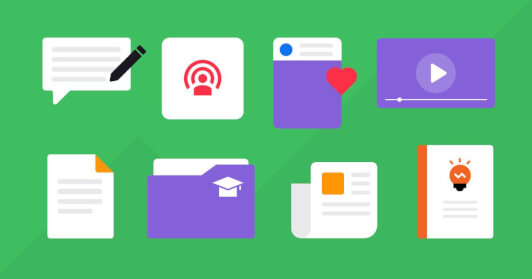Content marketing is a must for any serious business today. Gone are the days when pushy sales copy could make somebody buy on the first point of contact (thankfully). As consumers, we’ve become more discerning than ever and want to make sure we’ve found the right solution before making a purchase.
It’s no different with LSPs. Translation buyers will shop around to see what different providers are offering and who can be trusted to solve their problem. In other words, people want to know if the LSP is trustworthy before even thinking about buying from them.
So what’s the best way to build trust and get more customers today? Content.
The role of content marketing
The end goal of content is to encourage a flow of potential customers through the buyer’s journey. This means you need to create content for people at every stage, from those who are completely unaware of your LSP’s existence and know very little about the translation industry, through to those who want to learn about translation and the services available, to those who are ready to buy and need to make a final decision on who to work with.
But content creation doesn’t stop once the consumer makes a purchase. You also need to provide resources for existing customers to ensure they are happy with your services so that they become loyal clients.
Some content marketing numbers
According to the Content Marketing Institute, content marketing generates "over three times as many leads as outbound marketing and costs 62% less."
Companies with a blog have 67% more leads coming in than those without a blog.
More than 70% of B2B buyers consume blog content while on their buyer journey.
81% of consumers do some online research before making a large purchase.
What types of content can your LSP create?
Every piece of content must take into account where the consumer is on the buyer journey so what content works at each stage? Here’s a breakdown with the different types, goals, and examples:
Awareness stage
The purpose of content at this initial stage is to introduce people to the world of translation and localization. It’s important that you make no assumptions about what they know, which means your content should stay away from complex terminology that only industry insiders will be familiar with. Equally, provide explanations and definitions when necessary.
Types of content include blog posts, introductory articles, and social media posts. You could, for example, write a blog post about the difference between human translation and machine translation. This may seem very basic for those of us in the localization industry but there are plenty of people out there who simply aren’t aware of the implications of using one or another.
Consideration stage
At this stage, we can assume that the buyer has some knowledge about the industry, as well as their specific problem, and is exploring the options available to solve it. Bear in mind that the buyer may still not know much about translation or the different solutions available so your content should still be educational and easy to understand from an outsider’s point of view.
Types of content include whitepapers, ebooks, case studies, podcasts, and educational articles. A good piece of content could be a case study about a client of yours who has had great results since they started working with you. Another example might be a comparison article with the pros and cons of working with freelance translators versus an agency.
Decision stage
The prospect is now ready to buy and just needs to decide what language service provider to go with. They will have likely done extensive research to narrow down a final list of contenders and just need product or service specifics to seal the deal.
Your content should help the consumer understand the key benefits of your services as well as your company values. It’s at this point that you should focus on your Unique Value Proposition so that the prospect sees you as the only viable option if they want to enjoy that particular benefit.
Types of content that work well include emails, webinars, and demos. You could offer a webinar explaining the benefits of your services and the types of customers you help.
Retention stage
You’ve done the hardest part — the consumer has bought from you. But now you need to make sure you’re providing the buyer with all the resources they need to remain happy clients.
Content at this stage will be very practical and include materials like tutorials, knowledge bases, frequently asked questions, and how-to guides. If you have a client portal set up on your website for customers to send and receive orders on, one example could be to provide a practical step-by-step guide walking the customer through the whole process to ensure they make full use of the service and find it beneficial.
Content types are flexible
Note that these types of content are not fixed at every stage. In practice, you’ll find most formats can be applied and adapted to every stage of the buyer’s journey. For example, webinars and emails can be used at every stage of the buyer’s journey as long as they are adequately adapted to the consumer’s level of awareness and readiness to buy.
As a real example, here’s how Lichi Translations implements LSP marketing strategies:
Although blogs and newsletters don’t guarantee immediate business, these forms of communication increase the likelihood that the reader will reach out when they need these services.
Check out the full case study for more ideas on content and how to expand your reach.
Promotion is just as important
In an ideal world, good content would promote itself. Google is getting much better at sifting through content, but you’ve still got to promote it yourself to ensure it gets a fair chance of getting picked up and shared organically.
This means you’ll need to distribute it where your ideal customer is likely to be. Post about it on social media like Facebook, Twitter, Instagram, YouTube, or LinkedIn if your target audience uses these.
Aside from posting, you can go into groups, forums, and question-and-answer-type websites like Quora to see if someone has asked a question about a topic that your piece of content specifically addresses. Here’s a question on Quora about Google Translation.
When commenting on posts don’t just link to your content without providing some sort of answer first. You need to give them a reason to click on your content so always give some value first. If your content is useful and answers their question or solves their problem, they will likely share it with others who may at some point need your services too.
Additionally, if you don’t have an email list, you may want to consider starting one as email marketing is one of the most effective ways of promoting your online content.
Play the long game
If you’re looking for a quick win then content marketing will be very disappointing. It’s very much a long-term endeavor that will take time before you can reap the rewards. We live in a world with information overload, which makes it harder than ever to get people’s attention. If your goal is to grow sustainably and keep up with the competition in years to come you need a strong content strategy to stand out, be heard, and grow your audience.
So, focus on consistently providing genuinely useful content to your audience and you’ll eventually be rewarded with trust. And once you’ve gained their trust you’ll be top of mind when they’re eventually ready to buy.
Subscribe to our newsletter


